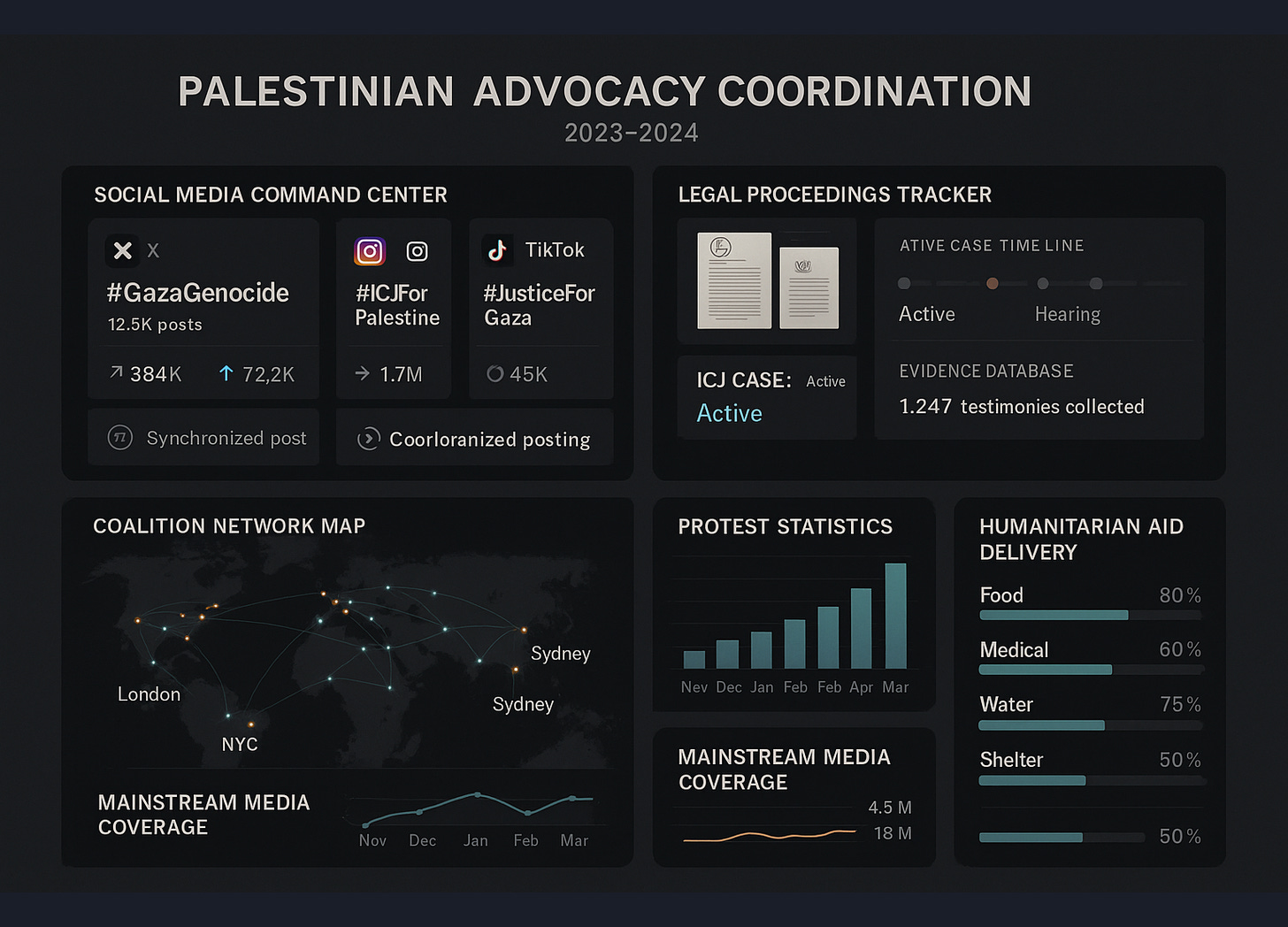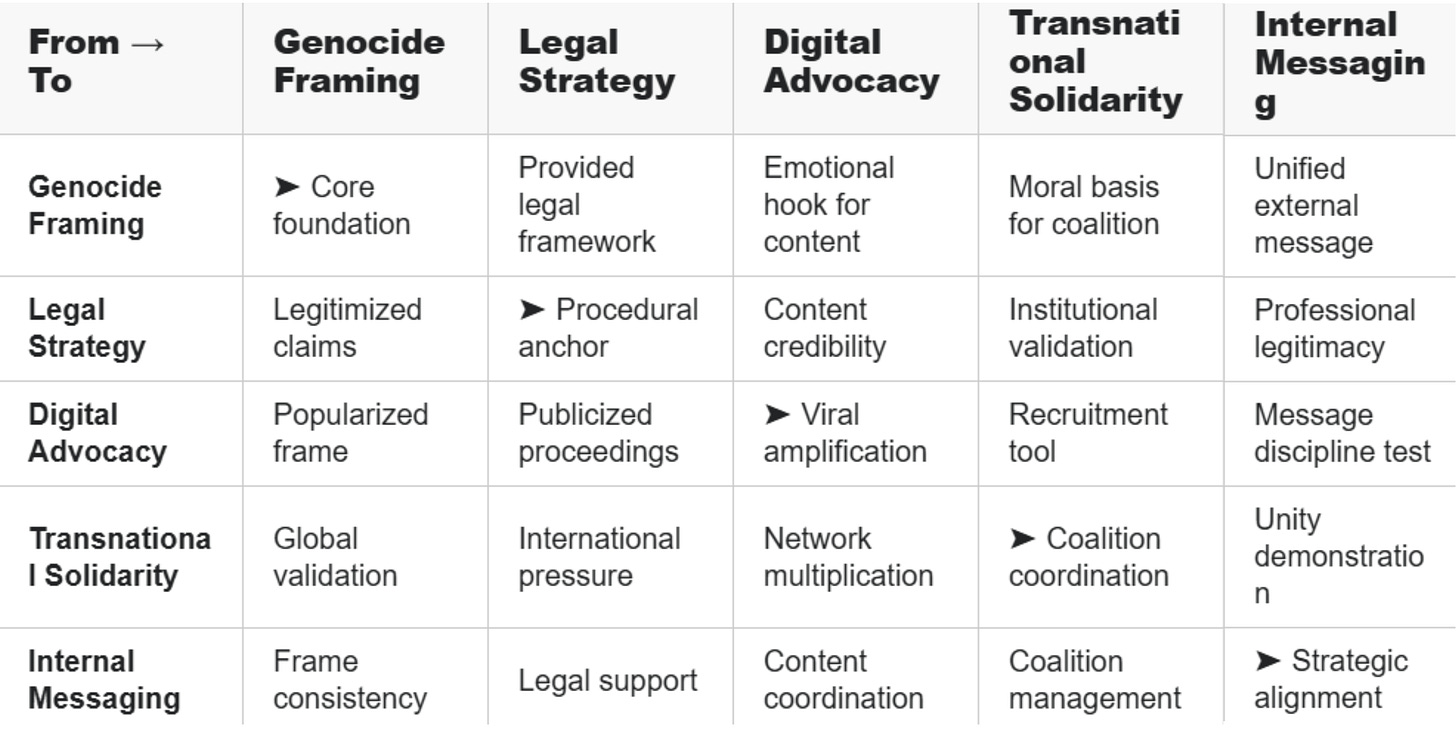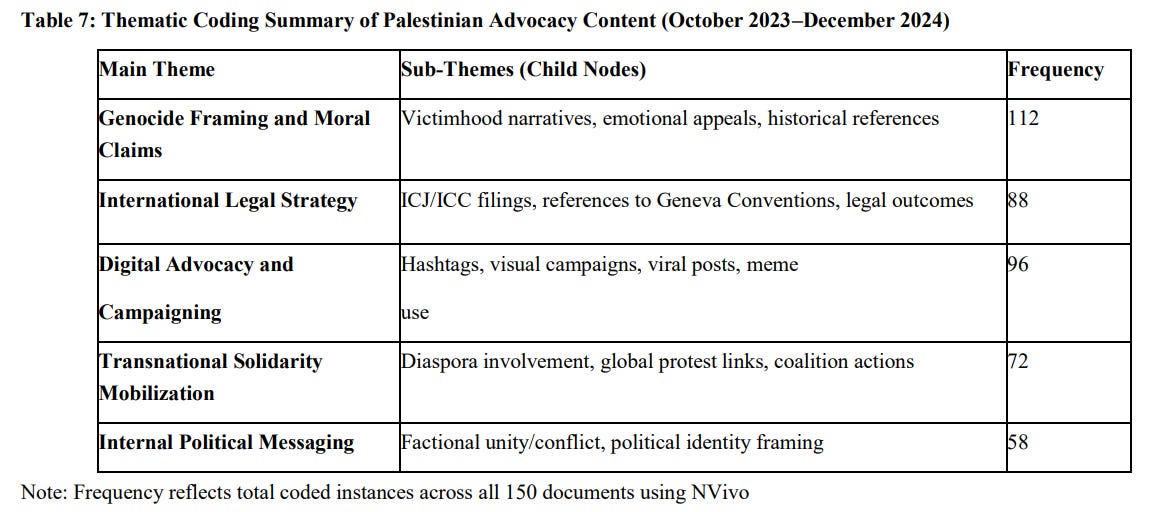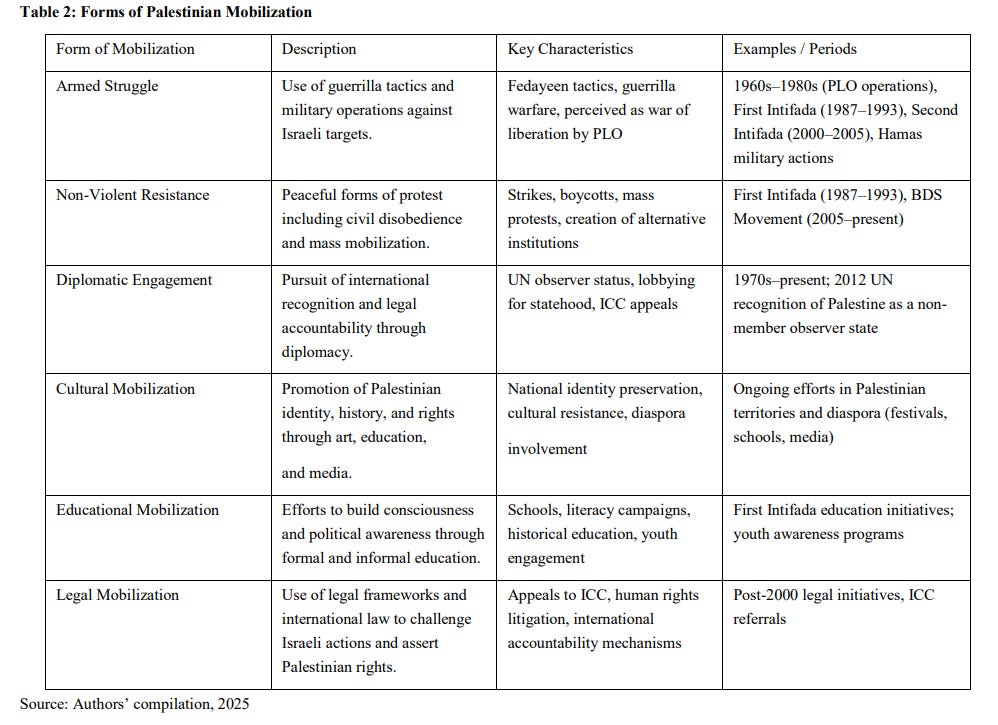Groundbreaking Academic Study Reveals Systematic Coordination of Pro-Palestine Movement
A comprehensive new academic study reveals the sophisticated, coordinated strategy behind Palestinian political mobilization—and why Jewish communities need to understand it
In the aftermath of October 7th and throughout the Israel-Hamas War, Jewish communities worldwide witnessed an unprecedented surge in anti-Israel sentiment that seemed to emerge with remarkable coordination and sophistication. Campus protests, international legal proceedings, viral social media campaigns, and diplomatic pressure appeared to materialize simultaneously across multiple fronts. For many in the Jewish community, this felt overwhelming and inexplicable—how could such a coordinated response emerge so quickly and effectively?
A groundbreaking academic study by researchers from Chukwuemeka Odumegwu Ojukwu University in Nigeria provides crucial answers. Their comprehensive analysis, "Political Mobilization and Advocacy Strategies of Palestinian Groups Amid Genocide Allegations in the Gaza Conflict, 2023-2024," offers the first systematic examination of how Palestinian political and civil society organizations orchestrated their advocacy efforts during this critical period. For Jewish communities seeking to understand the opposition they face, this research provides invaluable intelligence.
Why This Study Matters
This research fills a critical knowledge gap that has left Jewish advocacy efforts reactive rather than strategic. While extensive literature exists on the Gaza conflict itself, virtually no academic work has examined the sophisticated advocacy machinery that Palestinian groups deployed with such devastating effectiveness. Understanding these strategies is not about adopting them wholesale, but about recognizing the coordinated nature of the challenge facing Jewish communities and developing appropriate responses.
The study's importance extends beyond tactical knowledge. It reveals how Palestinian groups achieved something that has long eluded them: genuine unity of messaging across factional lines. Understanding how they overcame internal divisions to present a coordinated international front offers lessons for Jewish communities, who often struggle with their own internal disagreements undermining external advocacy efforts.
Research Methodology: A Comprehensive Analysis
The researchers employed rigorous qualitative methodology, systematically analyzing 150 documents published between October 2023 and December 2024. This comprehensive dataset included official political statements from Hamas and the Palestinian Authority, legal briefs submitted to international courts, civil society reports, mainstream media coverage, academic literature, and digital advocacy materials.
Using advanced thematic analysis software, the researchers identified patterns across these diverse sources, revealing five interconnected strategic pillars that functioned as a coordinated advocacy ecosystem. The methodology's strength lies in its breadth—capturing not just public-facing messaging, but also the coordination mechanisms that enabled such unified action across traditionally divided Palestinian factions.
The Five-Pillar Strategy: A Sophisticated Advocacy Machine
Pillar 1: Genocide Framing as Universal Language
The study's most striking finding is how Palestinian groups made genocide allegations the absolute center of their advocacy, with this framing appearing 112 times across all document types. This wasn't accidental rhetoric—it was strategic communication designed to serve multiple audiences simultaneously.
The genocide frame functioned as a "universal language" that could speak to international courts (providing legal grounds for ICC/ICJ cases), global public opinion (creating emotional resonance through historical comparisons), and diplomatic actors (offering moral justification for policy changes). Remarkably, groups as politically different as Hamas and the Palestinian Authority and everything in between used virtually identical genocide terminology, demonstrating unprecedented coordination.
For Jewish communities, this reveals a crucial insight: the "genocide" label—which already began cropping up mere days after the October 7th massacre—wasn't chosen for its accuracy, but for its strategic utility. It simultaneously delegitimizes Israel morally, provides legal grounds for international proceedings, and creates emotional connections by invoking historical tragedies—particularly the Holocaust itself.
Pillar 2: Legal Strategy as Legitimization Engine
Palestinian groups transformed their advocacy from political rhetoric into legally grounded claims through systematic engagement with international courts. The 88 instances of legal strategy documented in the study show how organizations like Al-Haq and the Palestinian Centre for Human Rights collected field evidence that served multiple purposes simultaneously.
The same testimonies and documentation appeared in ICJ briefs, social media content, and materials distributed to international coalition partners. Legal proceedings lent credibility to social media campaigns, while viral digital content generated public pressure supporting the legal cases—creating a self-reinforcing cycle of legitimacy.
Pillar 3: Digital Advocacy as Amplification Network
The study reveals a sophisticated hashtag ecosystem that created interconnected content webs across social media platforms. With 96 documented instances, digital advocacy wasn't random online activity—it was carefully coordinated content synchronized with legal filings, international protest dates, and breaking news events.
The hashtag strategy demonstrates remarkable strategic thinking: #GazaGenocide provided the primary narrative frame, #ICJForPalestine lent legal legitimacy, #JusticeForGaza offered moral appeal, and #FreePalestine articulated the political goal. Different platforms received optimized content while maintaining unified messaging—Twitter for real-time updates, Instagram for visual storytelling, TikTok for emotional short-form content, and Facebook for educational materials and event organization.
Pillar 4: Transnational Solidarity as Network Multiplier
Perhaps most impressively, Palestinian groups built a sophisticated three-tier coalition architecture that multiplied their advocacy capacity exponentially. Tier 1 partners included established human rights organizations providing credibility, Tier 2 partners were diaspora organizations offering local organizing capacity, and Tier 3 partners were solidarity movements providing grassroots mobilization.
The study documents 72 instances of coordinated transnational activity, revealing shared toolkits containing standardized talking points, legal case summaries, social media templates, and protest organizing guides. Global "days of action" were synchronized with legal milestones, creating the appearance of spontaneous worldwide support while actually representing carefully orchestrated coordination.
Pillar 5: Internal Unity Despite Political Differences
Most remarkably, the study shows how Palestinian groups achieved external messaging unity while maintaining distinct internal political positions. Hamas focused on “resistance” narratives for its base, the Palestinian Authority emphasized diplomatic solutions, and civil society groups stressed human rights approaches—yet all unified around genocide framing for international audiences.
This strategic discipline represents a major evolution in Palestinian advocacy. Previous efforts often failed because internal political divisions undermined external messaging. The 2023-2024 period demonstrates how sophisticated message coordination can overcome traditional factional barriers.
The Integrated Ecosystem: How the Pillars Reinforced Each Other
The study's most important finding is how these five pillars functioned as an integrated ecosystem where each component amplified the others. Legal proceedings provided content for digital campaigns, which generated public pressure supporting legal cases. Digital virality attracted coalition partners, whose networks exponentially expanded reach. Internal coordination ensured no contradictory messaging undermined external efforts.
The researchers document specific coordination mechanisms: content cross-pollination where legal evidence became digital content, temporal synchronization where all activities aligned with legal calendars, and audience segmentation where different messages reached different audiences while maintaining core genocide framing.
This created a "force multiplication effect" where each pillar's impact was exponentially increased by its connection to the others, resulting in unprecedented international attention, legal legitimacy, and political pressure.
Critical Lessons for Jewish Communities
Understanding the Opposition
Jewish communities must recognize they face not random anti-Israel sentiment, but a sophisticated, coordinated advocacy machine operating across legal, digital, coalition, and political dimensions simultaneously. The apparent spontaneity of campus protests, international legal cases, and diplomatic pressure represents careful strategic planning, not organic grassroots activism.
The Power of Unified Messaging
Palestinian groups achieved something Jewish communities often struggle with: message discipline across ideological differences. While Jewish organizations frequently undermine each other through public disagreements, Palestinian groups demonstrated how internal diversity can coexist with external unity when strategic coordination takes priority.
Multi-Platform Integration
The study reveals how effective advocacy requires coordination across legal, digital, coalition, and political platforms simultaneously. Jewish communities cannot match this with traditional approaches focused on single-issue campaigns or platform-specific efforts. The opposition operates as an integrated system—effective responses must do the same.
The Importance of Narrative Frameworks
The genocide frame's power lay not in its accuracy, but in its ability to serve multiple audiences simultaneously. Jewish communities need narrative frameworks that can speak to legal institutions, public opinion, and diplomatic actors with equal effectiveness. Traditional approaches focusing on historical rights or security concerns may be insufficient against frameworks designed for maximum strategic utility.
Moving Forward: Strategic Implications
This research provides Jewish communities with crucial intelligence about the sophisticated opposition they face. Understanding these strategies enables more effective responses—not through imitation, but through recognition of the coordinated nature of the challenge and development of appropriate counter-strategies.
The study demonstrates that effective modern advocacy requires integration across legal, digital, coalition, and political dimensions, unified messaging despite internal differences, and strategic frameworks designed for multiple audiences simultaneously. Jewish communities that understand these realities will be better positioned to defend Jewish interests in an increasingly complex information environment.
Most importantly, this research reveals that what Jewish communities experienced during 2023-2024 was not an inevitable result of Palestinian grievances, but the product of sophisticated strategic planning. Understanding the machinery behind the messaging is the first step toward developing effective responses to protect Jewish communities and support for Israel in future conflicts.
Click here to read the comprehensive analysis, "Political Mobilization and Advocacy Strategies of Palestinian Groups Amid Genocide Allegations in the Gaza Conflict, 2023-2024."







Shortly after 10/7, I joined an international group of media and communications professionals focused on developing a coordinated public relations response to the rising wave of antisemitism. Unfortunately, after months of work and discussion, the group could not agree on a message, an approach, or virtually anything else. While our enemies play chess, we argue about how to set up the pieces.
Very true - they have consistent messaging . Every PR statement / media appearance contains “ genocide” “ ethnic cleansing” ” famine/starvation”. We have a lot to learn.